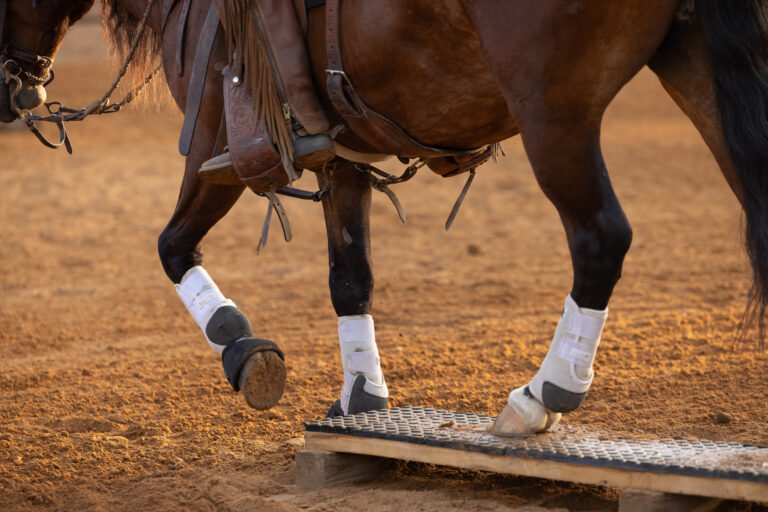If your senior horse is developing or managing osteoarthritis (OA), a chronic, progressive joint condition, it’s time to put thoughtful, season-specific care routines in place. The level of support your horse needs will depend on his diagnosis, activity level, and his discipline. But regardless of those factors, keeping him comfortable and mobile throughout the year is key to managing OA and preserving his quality of life. Try these tips to keep your arthritic senior feeling good all year round, brought to you by Zycosan, during our Osteoarthritis Awareness Month.

OA can’t be cured, but it can be managed. Try these simple tips to keep your senior OA horse feeling good year-round. Karlena/adobe.stock.com
Winter: Keep Him Moving and Hydrated
Cold weather can make stiff joints even stiffer, so maintaining movement is essential for arthritic horses in winter. Regular, low-impact activity helps encourage joint lubrication and supports muscle tone, which stabilizes joints. Even a few days without movement can worsen symptoms.
Winter can definitely make riding more challenging, so create a smaller turnout space with safe footing and natural windbreaks and access to shelter. You can even scatter hay piles throughout the area to encourage movement. And don’t forget hydration! Horses are prone to colic when hydration drops arthritic or not, but a senior horse battling osteoarthritis might be less eager to walk to water. Use tank heaters or offer warm water daily to increase consumption, especially when temperatures plummet, and make it easy to access. Keep heated buckets in the stall or be strategic with where you place water tanks so your senior doesn’t have to traverse slippery or unsafe footing to get to it.
Spring: Monitor the Mud and Get Moving Again
Spring is a great time to start easing your senior OA horse back into under-saddle work, if he’s sound enough for light riding. Again, motion is lotion for joints so best to keep him moving, however, melting snow and rain turn to mud and slippery footing, which is tough on arthritic joints. Avoid riding on uneven or slick surfaces, and focus on controlled, consistent exercise with proper warm-up and cool-down.
Regular farrier care for any horse is necessary for full-body equine health, but it’s also imperative to reduce joint strain and manage your horse’s OA condition. Your farrier can work with your vet to create a hoof care plan that will keep your senior horse balanced, comfortable, and striding out. This is also an ideal time for a spring wellness check: your vet can assess arthritis progression, adjust supplements or medications, and perform fecal testing to update your deworming schedule.
Summer: Keep Cool and Comfortable
Summertime riding is what we wait for all year, but your senior OA horse may struggle in the heat. Provide shaded turnout, safe barn fans, and avoid riding during the hottest hours of the day.
If your horse is capable of working more in summer, keep an eye on his weight, saddle fit, and overall comfort. A poorly fitting saddle can worsen joint pain. If your senior competes or is in regular work, consider equine bodywork or massage, joint supplements, or injections that might help keep him comfortable. And if he’s losing weight due to herd dynamics or heat, consider solo feeding or separating him during meals.
Fall: Plan Ahead for Winter
Cooler temps offer a second chance to fine-tune your senior OA horse’s care before winter. Schedule a fall vet visit to reassess his condition and tweak your management plan. Consider his upcoming winter shoeing needs, will he require pads or special shoes? Or should you be pulling shoes entirely, depending on his terrain and comfort level?
Continue prioritizing movement, especially if joint stiffness increases in cold weather. Take time while temps are still good to create or maintain safe footing in turnout areas, and ensure his nutrition is dialed in to avoid seasonal weight loss.
Year-Round Basics
No matter the season, these best practices help manage OA in senior horses:
- Keep him moving: Turnout or light exercise supports joint health.
- Use joint-supportive supplements or therapies as recommended by your vet.
- Stick to regular wellness exams to stay ahead of arthritis progression.
- Ensure food and water are easy to access, minimizing his need to navigate difficult terrain.
- Pay attention to small behavior or movement changes—these subtle shifts are often early red flags.
Osteoarthritis can’t be cured, but with consistent care and seasonal strategies, your senior horse can stay more comfortable, mobile, and happy all year long.
Now let’s put your knowledge to the test in this osteoarthritis trivia challenge!
Brought to you by:

Early Detection is 🔑:






